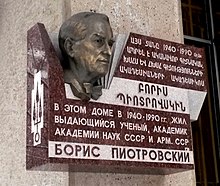| Boris Piotrovsky | |
|---|---|
 | |
| Born | (1908-02-14)February 14, 1908 Saint Petersburg, Russian Empire |
| Died | October 15, 1990(1990-10-15) (aged 82) Leningrad, Soviet Union |
| Resting place | Smolensky Cemetery, Saint Petersburg |
| Occupation(s) | Archaeologist, historian |
| Known for | Excavations of Karmir Blur (Teishebaini); studies on Urartu |
| Political party | CPSU (from 1945) |
Boris Borisovich Piotrovsky, also Piotrovskii (Russian: Бори́с Бори́сович Пиотро́вский; February 14 [O.S. February 1] 1908 – October 15, 1990) was a Soviet Russian academician, historian-orientalist and archaeologist who studied the ancient civilizations of Urartu, Scythia, and Nubia. He is best known as a key figure in the study of the Urartian civilization of the southern Caucasus. From 1964 until his death, Piotrovsky was also Director of the Hermitage Museum in Leningrad (now Saint Petersburg).
Biography
Piotrovsky was born in Saint Petersburg in 1908. He specialized in the history and archaeology of the Caucasus region and beginning in the 1930s, he began to acquaint himself with Urartian civilization. He was the head of 1939 excavations that uncovered the Urartian fortress of Teishebaini in Armenia (known in Armenian as Karmir Blur, or Red Hill). Evidence found there has been key in understanding the Urartian civilization. Piotrovsky lead further excavations in Armenia in the ancient settlements of Tsovinar, Redkig-lager, Kirovakan (now Vanadzor) and Aygevan until 1971.
These were not Piotrovsky's sole contributions in the archaeological field, however. Piotrovsky worked elsewhere in the Caucasus, especially on the Scythian culture. In 1961, he was placed at the head of an expedition of the Academy of Sciences of the Soviet Union to study Nubian monuments in Egypt. He also spent 26 years as Director of the Hermitage Museum, which has been run by his son Mikhail thereafter. He was also the supervisor of the renowned Armenian archaeologist Gregory Areshian. The Hermitage holds an annual conference in his honor. He died of a cerebral hemorrhage in Leningrad in 1990 at the age of 82.
He was married to Hripsime Djanpoladjian, who was an archaeologist and epigrapher.
Works
In his lifetime, he published more than 200 works in the fields of archaeology, history and art. One of Piotrovsky's most important works is The History of Urartu and its Culture, published in 1944 and which went on to receive the Stalin Prize in 1946. Other notable works include:
- Urartu: The Kingdom of Van and Its Art (1967)
- The Ancient Civilization of Urartu (1969)
- The Hermitage: Its History and Collections (1982)
Honours and awards

- Hero of Socialist Labour (1983)
- Three Orders of Lenin
- Order of the October Revolution
- Three Orders of the Red Banner of Labour
- Medal "For the Defence of Leningrad"
- Medal "For Valiant Labour in the Great Patriotic War 1941–1945"
- Medal "In Commemoration of the 250th Anniversary of Leningrad"
- Jubilee Medal "Twenty Years of Victory in the Great Patriotic War 1941–1945"
- Jubilee Medal "Thirty Years of Victory in the Great Patriotic War 1941–1945"
- Jubilee Medal "Forty Years of Victory in the Great Patriotic War 1941–1945"
- Commander of the Ordre des Arts et des Lettres (France)
References
- ^ Wire report from the Associated Press. "Boris B. Piotrovsky, Archeologist; Director of the Hermitage Was 82." The New York Times. October 17, 1990. Retrieved July 21, 2008.
- ^ (in Armenian) Areshyan, Gregory. «Պիոտրովսկի» (Piotrovsky). Soviet Armenian Encyclopedia. vol. ix. Yerevan, Armenian SSR: Armenian Academy of Sciences, 1983, p. 302.
- The State Hermitage Museum. The Hermitage Readings in memory of Boris Piotrovsky (1908–1990) Archived March 9, 2005, at the Wayback Machine. Accessed July 22, 2008.
- "MIKHAIL PIOTROVSKY". Aurora prize.
External links
- The Art and Culture of the Peoples of the Caucasus: 1100 B.C.–19th century (From the Hermitage website. One of the sections explains the importance of Teishbaini.)
- Conference announcement for the conference in Piotrovsky's honor. Gives some biographical information.
- 1908 births
- 1990 deaths
- 20th-century archaeologists
- 20th-century Russian historians
- Archaeologists from Saint Petersburg
- Communist Party of the Soviet Union members
- Corresponding fellows of the British Academy
- Corresponding members of the Académie des Inscriptions et Belles-Lettres
- Directors of the Hermitage Museum
- Full Members of the USSR Academy of Sciences
- Members of the Academy of the Kingdom of Morocco
- Saint Petersburg State University alumni
- Commandeurs of the Ordre des Arts et des Lettres
- Heroes of Socialist Labour
- Recipients of the Order of Lenin
- Recipients of the Order of the October Revolution
- Recipients of the Order of the Red Banner of Labour
- Recipients of the Pour le Mérite (civil class)
- Recipients of the Stalin Prize
- Armenian studies scholars
- Museologists
- Russian archaeologists
- Russian orientalists
- Soviet archaeologists
- Soviet historians
- Soviet orientalists
- Burials at Smolensky Cemetery